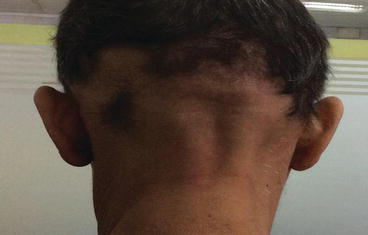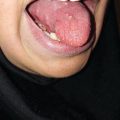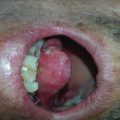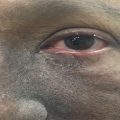, Ahmad Ameri1 and Mona Malekzadeh2
(1)
Department of Clinical Oncology, Imam Hossein Educational Hospital, Shahid Beheshti University of Medical Sciences (SBMU), Shahid Madani Street, Tehran, Iran
(2)
Department of Radiotherapy and Oncology, Shohadaye Tajrish Educational Hospital Shahid Beheshti University of Medical Sciences (SBMU), Tehran, Iran
Whenever the skin is irradiated, hair loss may occur as a side effect. Because hair loss of scalp induced by radiation of brain or head and neck cancer has a significant importance due to its effect on appearance (Fig. 2.1), we focus on scalp hair loss in this chapter.


Fig. 2.1
Hair loss at posterior scalp after radiation therapy for sinonasal tumor that exposed to exit dose of antro-posterior radiation beam
Hair loss may be a temporary or permanent radiation side effect depending on radiation dose [1]. Temporary hair loss is typically observed in all patients undergoing whole-brain radiation therapy [2, 3]. Temporary hair loss with some areas of permanent alopecia is one of the common complications (more than 10 out of 100), in patients with primary brain tumors treated with cranial radiation therapy [4]. Permanent hair loss occurs in 50% of patients with the follicle dose of 43.0 Gy [5].
2.1 Mechanism
Radiation-induced hair loss is due to high susceptibility of anagen follicles to radiation.
Hair follicles are located approximately 3–5 mm below the scalp [6]. Hair growth has a cyclical process [7]. The three phases during the hair life cycle are anagen (active phase), catagen (transitional phase), and telogen (resting phase). Most hairs are normally in the anagen phase. During this phase, the bulb matrix cells are rapidly proliferating with high mitotic activity [8–10]. Any acute damage to actively dividing matrix cells of anagen follicles leads to abrupt loss of hairs called anagen effluvium. Chemotherapy and radiation therapy are common causes of anagen effluvium [8, 9, 11, 12].
2.2 Timing
Hair shedding may start as soon as 1–3 weeks after the first dose of radiation [17]. The hair follicle resumes normal cycling within a few weeks of treatment cessation [9] and usually resolves within 2–3 months after completion of radiation therapy [5]. Regrowth of hair may be sparser with different thickness or texture after treatment.
2.2.1 Risk Factors
Radiation dose is the most significant factor-related radiation-induced alopecia. Temporary alopecia can be detected after doses of about 2 Gy [18]. Permanent alopecia has been reported in a range of 0–80% (median risk 5%) of patients with dose of 36 Gy (2 Gy/fraction, 5 d/wk) and of 5–100% (median 15%) of patients with a dose of 45 Gy. Permanent alopecia occurs with a 7 Gy single-fraction dose [5].
Lower-beam energies, use of multiple overlapping beams, or use of fixation materials with high thicknesses can increase the risk of radiation-induced alopecia [5].
Previous or concomitant chemotherapy (alkylating agents most commonly reported) increase the risk of radiation-induced alopecia [5, 19].
Patients with personal history of alopecia may have a trend of developing permanent alopecia. Patient’s age, family history of baldness, gender, tobacco use, and diabetes have not reported to correlate with alopecia [5].
2.2.2 Symptoms
Radiation therapy will generally cause alopecia limited to the treated area but may also occur in the adjacent area due to beam penumbra or at existing areas of the radiation beam.
After hair loss, scalp is sensitive to radiation damage and radiation dermatitis may occur (see Chap. 1).
2.3 Scoring
Common Terminology Criteria for Adverse Events (CTCAE) v4.0 has defined two scores for hair loss of scalp (Table 2.1) [20].
Table 2.1
CTCAE hair loss scoring
Definition | |
|---|---|
Score 1 | Hair loss of <50% of normal for that individual that is not obvious from distance but only on close inspection; a different hairstyle may be required to cover the hair loss, but it does not require a wig or hairpiece to camouflage |
Score 2 | Hair loss of ≥50% normal for that individual that is readily apparent to others; a wig or hairpiece is necessary if the patient desires to completely camouflage the hair loss; associated with psychosocial impact |
2.4 Prevention
It has been shown that patients affected by hair loss have a poorer quality of life, lower self-esteem, and heightened self-consciousness [21, 22]. Novel strategies to decrease radiation-induced alopecia have been proposed. New radiation delivery techniques such as intensity-modulated radiation therapy (IMRT) or volumetrically modulated arc therapy (VMAT) for whole-brain radiation therapy (WBRT) are being evaluated to reduce the dose to the hair follicles [3, 23–25]. Primary results of these techniques are promising, which warrant further investigation.
Tempol, formally 4-hydroxy-2,2,6,6-tetramethylpiperidin-1-oxyl, is a membrane-permeable radical scavenger. Both the preclinical and clinical studies showed that topical application of tempol may be effective at preventing radiation-induced alopecia [26–28]. Larger studies are needed to evaluate its efficacy and safety in clinical practice.
Antioxidant compounds such as glutathione, lipoic acid, and antioxidant vitamins A, C, and E could act as natural radioprotectors and reduce the toxicity of radiation therapy. But possible tumor-protective effects of these nonselective free-radical scavengers are matters of great concern. Topical application of these antioxidants has been tested to reduce systemic absorption and subsequent tumor protection, but this does not seem to be able to eliminate the tumor-protective effect. Additional studies need to determine the safety of using these agents during radiation therapy [29].
Base on preclinical studies, systemic and topical application of prostaglandin E2, systemic administration of vitamin D3, topically applied vasoconstrictors, subcutaneously applied keratinocyte growth factor, Panax ginseng administration, and caffeine may protect hair follicles from radiation toxicity [30–34]. Further clinical trials should be conducted to prove the preventive effect of these agents on radiation-induced alopecia.
2.5 Management
General recommendations during treatment may be helpful for the patient to minimize scalp reaction including avoiding excessively hair combing, hair color and hair styling products, hair dryers, using baby shampoo or other mild shampoo and hair conditioner without any perfumes, and cutting hair to medium to short lengths [35].
Reconstructive surgery options can be considered in selective patients with postradiation therapy and permanent alopecia based on alopecia area, size, patient’s age, and prognosis [36].
Botulinum toxin type A (BTXA) is used successfully to treat radiation-induced alopecia in a case report, which warrants more studies to identify the mechanisms and efficacy of BTXA [37].
There are no reports about other hair loss treatments such as minoxidil or low-level laser therapy in the setting of radiation-induced hair loss.







